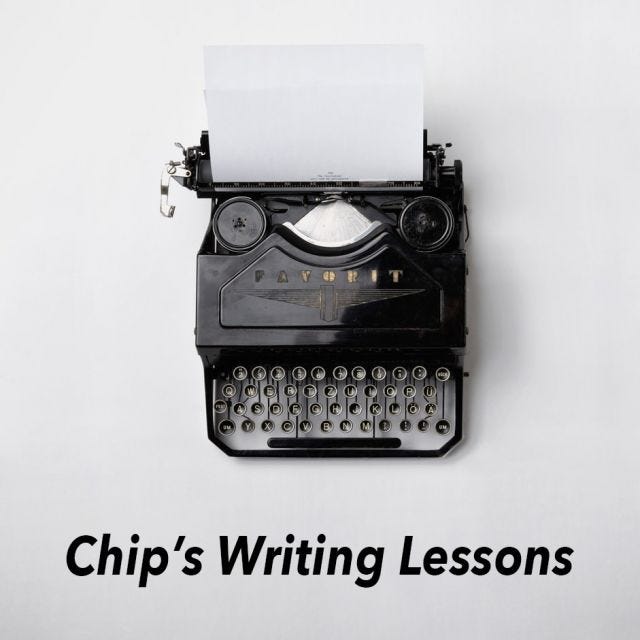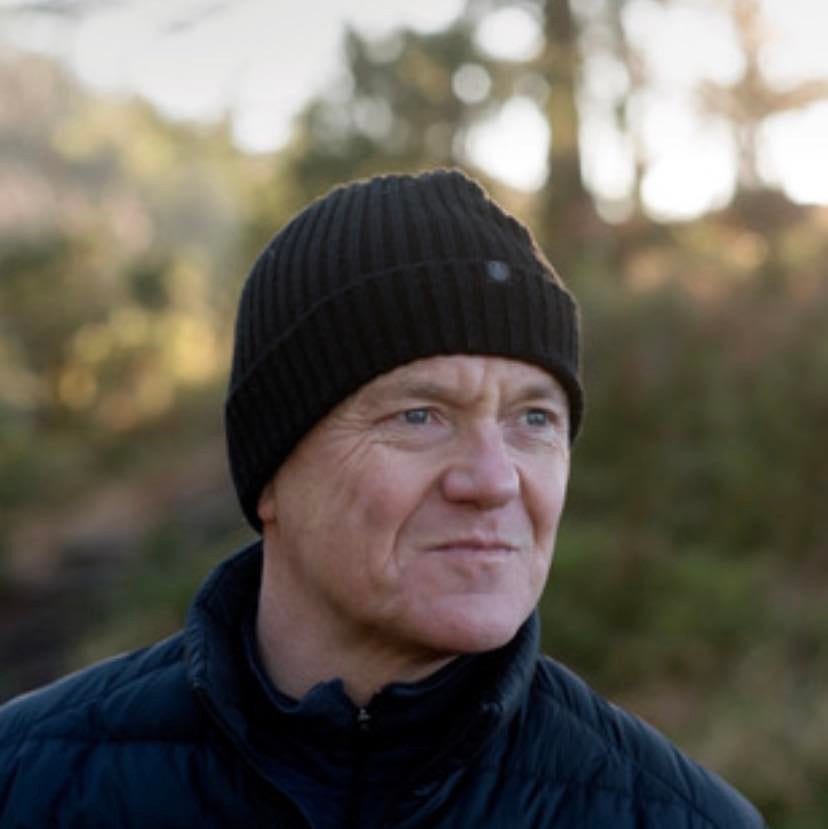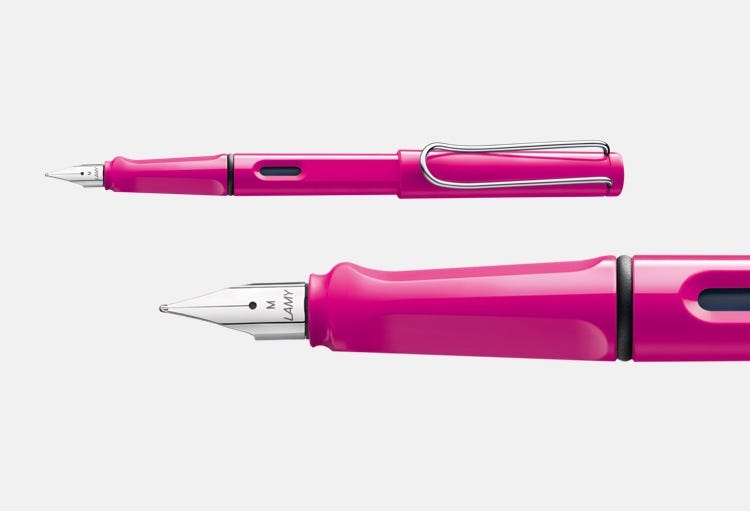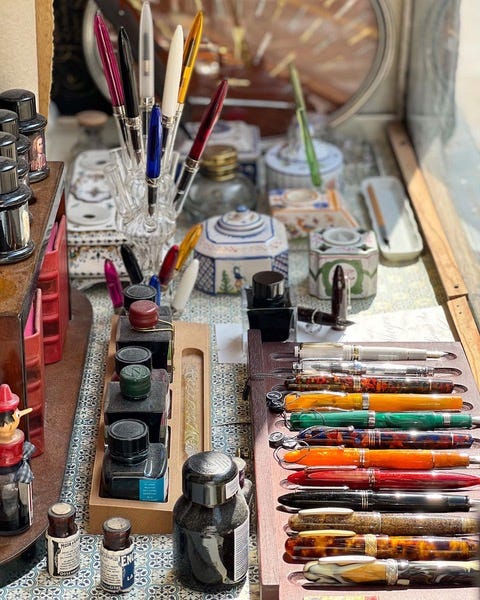In this issue:
Writers Speak | Katherine Anne Porter on the fullness of the writing life
Interview | 4 Questions with Bjørn Asle Nord
Writing to Savor | “Sins of the Father,” by Eric Pape, the Atavist, March 2023
Postcard from Paris | A stylophile’s paradise
Tip of the week | When stuck, organize with notecards
Help Royal Hospitallers, Ukraine’s brave paramedics
WRITERS SPEAK
“Writing does not exclude the full life. It demands it.”
-Katherine Anne Porter
4 QUESTIONS WITH BJØRN ASLE NORD
Bjørn Asle Nord founded the annual Power of Storytelling conference (Fortellingens kraft) in 2016, the largest in Scandinavia. He is an award-winning journalist, non-fiction author and lecturer. Nord works at the Norwegian Broadcasting Corporation (NRK) with digital and investigative climate and nature stories. For 28 years, he was a journalist for the newspaper Bergens Tidende and from 2004 until 2019 he worked with narrative journalism and in-depth journalism for their magazine. He has written two books: Five Feet Under: A Father, a Daughter and the Struggle to Survive (Skredet), and Give Me Rather Life (Gi meg heller livet), a documentary about mentally wounded soldiers, co-created with photographer Håvard Bjelland.
What is the most important lesson you’ve learned as a writer?
The importance of awareness. The payoff of being conscious of every step in the writing process.
The gain of being alert to every word I choose, every sentence I craft, every opening scene I polish, and every tricky middle part I repeatedly work on.
Why do I write this piece? Why do I include this sentence? Why did I use that phrase? Where do I use the most telling details? Where do I place the subject, the verb and the most empathic word?
Is this text visual? Does it give the reader awards? Do I scatter my gold coins at the right moment?
Where do I place the camera? Where do I zoom in, when do I slow down, where do I change pace?
How do I end this piece so it sings and rings in the reader's ears for years?
Awareness replaces shortcuts and carelessness and also eliminates mistakes, as line by line I check every detail, fact or emotional, data or observation, everything. I triple-check all my stuff and try to eliminate any ammunition against the piece.
My writing needs constant awareness, never indifference, or else I gain no distinction.
As soon as I stop being aware of my choices, when I am just writing words, with no emotions, without passion, lamed by bluntness, with research limited to my office desk, then I start writing poorly.
I am echoing a machine. I sound like the last academic report I read. I am the voice of the email I got from an ignorant politician. I write like a scheduled bureaucrat.
This is the punishment for dullness.
The finest thing about this work is its imperfection. There is no answer book, no finishing line. It is a never-ending story to write; I can always improve, the best sentence is not written and I have not yet told the most compelling story.
Another payoff from this lesson is, yes, it is possible to educate yourself and learn this craft and improve.
I was not born a writer. I might have a talent, but the key to improvement is hidden in my hunger and buried in my personality.
As I become a better writer, I understand how little I still master and the more help and coaching I need.
Writing can be painful, it can be frustrating, and it can be joyful.
Being an aware writer gives my life an engine and energy.
What has been the biggest surprise of your writing life?
When we had this revolutionary shift from paper to digital, from print to mobile phone, as our platform for news and stories, there was a lot of skepticism about how this would end, especially for longer stories and in-depth journalism.
I found out quite early that narrative journalism and the techniques and tools related to it were created for the phone. It was like “happy thumb” married to “what happens next.”
When we started to publish long, compelling narrative stories online, they outperformed nearly all other writing published when it came to page views, and with surprisingly long reading time for the most riveting stories.
The best-told stories, the powerful narrative pieces, paired with strong visual elements, won readers. I was not as surprised as our editors. I had that feeling because I connected a lot with readers also before this shift.
It was so energizing to discover this, and so inspiring to see my stories, and the terrific work of other missionaries of narrative writing, top the hit list from week to week. It made me feel alive and kicking harder than ever as a writer and journalist.
Finally, we knew that ordinary people actually read long pieces and engaged, which gave us the proof, more space and power to develop the genre.
We could measure it and not only base our strong voice for this work on a gut feeling or some elite feedback.
The engagement we could create was powerful and helped my colleagues and me to break through. The stories opened up and changed poor public systems. Viral stories were made to hold the powerful accountable.
Good writing was not a mismatch with this revolution. It demanded that we sharpen our tools, take our readers more seriously and write better, less boring and less traditional stories with the mobile phone platform in our mind.
The biggest surprise is that some editors and writers still don't pay attention to the potential of creative writing.
Students and young writers need to know that using all the creative writing tools gives a bigger advantage as a journalist than any other skill.
One of the most surprising and influential journalists to support the work of narrative writers in Norway and elsewhere is Mario Garcia, one of the most prominent designers in the news world:
“The power of good writing is key. Always was. Always will be,” he said. “It is an even more essential attribute for stories that will be consumed on mobile devices.”
If you had to use a metaphor to describe yourself as a writer, what would it be?
A warrior and athlete (with an artistic touch and the outsider's voice).
My profile on my Twitter account says this in Norwegian:
“Med sans for kraften i historier. Trives best utenfor flokken. Går i krigen for rette laget.”
This is tricky to translate, but I will try.
“With a flair for the power of stories. I am most comfortable with not following the herd. I pick my fights for the right team.”
My best-written stories begin with my own emotions that propel my curiosity, reveal strong motivation and end up with what is really worth struggling for, diving deep into.
When I talk about a big narrative or investigative project and about reaching our highest level, I advise finding the story, the idea we really think is worth investing all our skills, our energy, and dedicating our brain to 24/7.
Go for what connects with your emotions in some way, and that lifts something you care about and you feel nearly obliged to tell. If it doesn't move you, how will you be able to move others?
When I write those in-depth stories, big narrative pieces, when I tap my fingers on the keyboard, and at my most intense sound like a machine gun, as I moan and grunt along, I need that feeling:
I am on a greater mission for my best companion, the reader. I will listen to the quiet. I will see the unseen. I will bring the outsiders to the floodlight on the stage.
I am on a mission for true stories, told with human voice and experience, updated with the sound of nature and armed with empathy and curiosity.
When I wrote a 10,000-word piece, Five Feet Under, it was a dramatic and cinematic story that captured readers to the last, cold breath.
A young woman was trapped beneath the snow in the remote Norwegian mountains. A father clawed himself out after a big avalanche and then started desperately searching for her.
She was saved by a dog after a huge rescue operation, after four hours and 16 minutes beneath the snow, with a 0.5 percent chance of survival.
It was a riveting and nail-biting drama. But I needed a mission to really dig out the whole story with all its fragments and details. I needed a mission to spend my next six months and my brain 24/7 in the most intense period.
I decided that the little Viking warrior inside me should struggle for a specific motivation and meaning:
Exposing humanity and the best things in our Norwegian culture, volunteering and life-rescuing work. In other words: The never walk alone value.
This universal story reached readers around the globe, generating massive responses in several languages.
I like to think in such terms when I dive into complicated cases. I like the superpower in the word warrior.
It makes me keep going on behalf of something bigger than myself.
It makes me feel stronger when I want to expose the neglect of nature, or vulnerable individuals and groups.
I battle for the narrative elements, action, setting, voice, character, scenes, details, observation, dialogue, pace, structure and theme. All those sharp tools we arm ourselves with as creative writers. And the X factor.
In 2016, the paper I worked for cut a lot of the staff and shut down the magazine department where I belonged. I lost my writing family.
Every writer needs a family. Colleagues to lean on. Brothers and sisters in arms to build a culture. Brilliant colleagues to reach for, to become better among the best writers.
It was fight or die.
Instead of waving the white flag, I whistled for a bigger and better family. I founded a writing conference with Mark Kramer, a master narrative teacher from Boston as my godfather and mentor.
Today the conference Fortellingens Kraft (The Power of Storytelling) is the greatest gathering for narrative journalists in Scandinavia.
I need to feel invincible. The worst battles many of us as have as writers are probably against ourselves. My internal warrior helps me overcome obstacles as minefields in my mind.
That transports me to my second metaphor.
I see myself as a top athlete when I write.
I worked for 13 years as a sports reporter. I learned a lot when covering intense drama from the Winter and Summer Olympics, soccer games, World Cups, and boxing rings.
I harnessed the story with the deadline parallel to the end of the games. I learned to stay focused, to be in the moment, in the tense dramas with all senses, on my tiptoes, and write in that bubble, in that intense flow.
From studying top athletes, I learned a lot. The winner’s mentality. Their abilities to set goals. Conscious mindset and attitude. The meaning of passion.
Another key to success is repetition. Write and revise. Over and over again.
It will never be perfect, that is impossible, but far better than mediocre, and sometimes I hit the top.
The best athletes look up to and learn from others, from the very best in the game they practice. They train with or study the best. They collaborate and learn from other top athletes in different sports.
I do so with my writing.
I constantly develop my skills. If I want to perform at the highest level and improve and win? Well, then I find the best and learn from them.
Watch and study how they solve their work, and learn their secrets.
I used this approach when I jumped from sport to feature and narrative writing in 2004. I started to visit conferences with the best writers. I found a mentor in Denmark, Kim Faber, today a successful crime novelist.
I learned from the best.
I visited the Tampa Bay Times and spent a day with Pulitzer Prize winner Lane DeGregory to watch her work and learn from her and her paper.
I went to the Poynter Institute later the same year, in 2012, for a one-week seminar in narrative writing and coaching with such mentors and world-class journalists and teachers as Jacqui Banaszynski, Tom French, and Roy Peter Clark. I went to Boston to learn from Mister Narrative himself, Mark Kramer.
These steps were career-changing.
Set a concrete goal and find out how to reach it.
Ask yourself: What will I achieve with this piece of writing?
I want to reach out with the most complicated issues in our time, climate change and the nature crisis.
How can I reach a massive audience and influence people and those in power with my writing?
I want to keep that artistic part alive in my writing. That individual tone.
Yes, I am a team player, but each winning team consists of individual voices, personalities, and artistic and specified skills.
I am the one who never gives up. Never leaves my companion behind.
I work hard. Harder than our opponents. Hard work is the most important skill.
Sometimes, I score an elegant goal.
What is the best piece of writing advice anyone ever gave you?
I have been lucky to learn from some of the best in this game. I am finding new pieces from every brilliant conference talk I listen to or writing book I read.
It can be Tom French's advice.
His strong cinematic approach with sequencing.
His “smell the deepest trigger of emotions.”
His “keep it simple” and “what happens next?”
His “harness the engine, finding the key question the whole story should answer” and “identify the line of action, follow your main character along that line.” Or his “open strong, build for stronger.”
Or Mark Kramer’s “the reader's sense of who is talking to them” or his “electrification of the text” when revising, making the language more active, and visual.
It could be Roy Peter Clark's many tools such as “don't just write words, write music” or his classic “empathic word order.”
“Place the emphatic words in a sentence at the end, application of this tool will improve your prose in a flash,” he says.
The first time I really tried it out the text went viral, and then the next one, and the next one. It was such a powerful twist.
I conquered the readers and the most read-article list regularly with this eye-opener.
I could have mentioned so many other tips and advice on such a list, but if I had to single out one it must be this, which I learned at the Poynter seminar back in 2012:
“Keep asking yourself, over and over, beneath the surface, what is this story really about.”
Say it in one word, the theme, the universal connection.
During the week of this seminar, this was the center of all we learned and all we practiced.
It was so simple, so hard, so difficult. But extremely useful.
It helped me to sharpen ideas and narrow, and to zoom in. It helped me to organize my research, pick and choose scenes and leave stuff out.
It helped me to see ideas others could not spot, so I found the gold coins others ignored.
It helped me identify the story that reached half a million readers. It gave me a long read that went worldwide.
It helped me write a book with stories about mentally wounded soldiers.
And it helped me to complete a mission impossible: A visually driven story told “underwater” about human impact on our oceans, and what we are doing to the oceans off our long coastline.
A great story about the state of our sea told in a way nobody had done before, and it should be wet, beautiful and painful at the same time.
One word solved this overwhelming project. The one-word trick. We narrowed it down to one simple word:
Neglect.
The ocean is our best friend. The ocean gives us every second breath we inhale. The ocean protects us against global warming. The ocean gives us wealth and welfare. If the sea lives, we survive.
The mission: Make us care more about our best friend. Make us act.
The use of this tool, hitting the universal word, helped us to find human experience.
It helped us to organize the whole piece, selecting stories, scenes, details, photos, and documentation.
We found those with human experience beneath the surface. Underwater and nature photographers. Some of the best in the world.
We framed the whole project around them, their actions, photos and voices. We placed the cameras on their shoulders.
We dived down for a long underwater journey.
One story framed the whole massive article:
A whale tangled. It all started like this, with this lead:
“Dive down with us. In search of our own traces. What are we doing to the ocean off our long coastline?
This story went viral on NRK and reached about 900,000 page views. The population in Norway is 5.4 million.
WRITING TO SAVOR | “SINS OF THE FATHER,” BY ERIC PAPE, THE ATAVIST, MARCH 2023
“When Lesley Hu wanted to vaccinate her young son, her conspiracy-obsessed ex-husband went to unimaginable lengths to stop her.” That caption on this story’s first photo is as far as I can go in describing this disturbing, engrossing narrative other than to say that it gives a vivid portrayal of the way conspiracy theories can seize hold of a person and make them do things that are, in a word, crazy. No way did I imagine the ending, a tribute to Pape’s storytelling skills.
POSTCARD FROM PARIS | A STYLOPHILE’S PARADISE
In kindergarten, my Catholic mother told me that if I said nine Hail Marys every Tuesday, the Blessed Mother would give me something I wanted. Of course, I dutifully said my prayers. Then Mom asked what I wanted. Without a moment’s hesitation, I cried out. “A fountain pen!”
Mom walked me across the street to Woolworth’s, where she purchased my first fountain pen, a Sheaffer, for 29 cents.
Thus began my life as a writer and, more importantly for this postcard, a stylophile, which is a person, according to the Urban Dictionary, “who finds fountain pens inherently interesting.”
I began collecting them more than two decades ago when I looked for one to celebrate my 50th birthday and realized most were out of my price range. Fortunately, I stumbled into the world of less-expensive, vintage fountains pens, specifically those manufactured during World War II, which corresponded to my budget and lifelong fascination with that conflict.
Here’s a photo of a portion of my collection.
My penmanship, as the nuns at St. Mary’s would have told you, is execrable, but a fountain pen in your hand trains your fine motor skills, among other benefits. You’re forced to write more slowly, and the result is much clearer.
I just like the feel of a fountain pen in my hand. I’ve spent hours cleaning and polishing them, which makes me a dork or a hobbyist, or both. But stylophilia, which sounds like a disease, is the only hobby I’ve ever had.
I’m passing it on to another generation. My three grandchildren, 11, 7 and 5, are fascinated by my pens and love to write and draw with them.
I’ve gone more modern recently, buying inexpensive German-made Lamy Safari pens, a favorite, under $25, of many writers I know.
In Paris last September, I discovered Melodies Graphiques, a tiny (by American standards) and magical papeterie, or stationery store, in the Marais District on the right bank of the Seine River. It was like walking into Woolworth’s when I was five years old, only much, much better.
The shop is run by a genial Italian, Giacomo Nottiani, who stocks inks, dazzling notebooks, and jaw-dropping fountain pens.
We visited him this week, the very day we arrived. He showed me his latest arrival, a sleek orange metal Kaweco made in Nuremberg, Germany. I hesitated for two days because it cost $77, not that expensive but more than I have spent on a pen in a long time. On day three, I caved.
I brought it home this evening and wrote a postcard with it to my Nieman Storyboard editor, Jacqui Banaszynski, whose belief in the value of writing postcards inspired this mini-series while I’m visiting Paris. In the parlance of stylophiles, it’s a good writer.
TIP OF THE WEEK | WHEN STUCK, ORGANIZE WITH NOTECARDS.
Screenwriters use notecards to map out their scripts. Since narratives are built on scenes, notecards are an eminently useful way to organize your story, whatever the genre. That was the way documentarian Erin Lee Carr broke through writer’s block as she wrote her memoir, “All That You Leave Behind,” about her relationship with her father, the late New York Times reporter and columnist David Carr. “From the beginning I found myself deeply challenged and stuck — freaked out by the blank page,” she said. “So I started to use my skills as a filmmaker. I note-carded it. I had the notes above my computer, and I got to do a little ‘X’ when I finished the draft of a chapter; it was this really satisfying moment.” Notecards are ideal for shorthand descriptors of scenes and you can shift the order to your heart’s content.
HELP UKRAINIAN PARAMEDICS SAVE LIVES
Royal Hospitallers, Ukraine's brave volunteer paramedic battalion, save lives every day in the war against Russia. Please support them here!
BEFORE YOU GO
If there’s one person you think would benefit from the interviews, craft lessons, writing tips, and more that appear every two weeks in my free newsletter, please suggest they subscribe, perhaps even become a paid subscriber. As you know, these members receive an extras package featuring excerpts from my books of writing advice, fresh interviews with leading writers and editors, inspirational quotes, coaching tips, my memoir-in-progress about my time as a Peace Corps volunteer in Africa, and more recommended readings and listening options.
MY BOOKS ARE AVAILABLE ON AMAZON AND TOMBOLO BOOKS, A LOCAL INDEPENDENT BOOKSTORE
33 Ways Not To Screw Up Your Journalism
Also available as an audiobook on Spotify and Amazon.
Writers on Writing: Inside the lives of 55 distinguished writers and editors “By asking four questions to 55 of our finest writers and editors, Chip Scanlan has hosted one of the greatest writing conferences you will ever attend." Roy Peter Clark, The Poynter Institute, “Writing Tools.”
"A marvelous book for writers, people who have a passion for writing, or simply, who want to become writers. Yet what strikes me about this book is that it is not just for writers only." The Blogging Owl.
Writers on Writing: The Journal
Available on Amazon and from Tombolo Books, a local independently-owned bookstore
chipscan@gmail.com | +1-727-366-8119
As always, thanks for reading and contributing. May your writing go well.










Thanks for the great conversation with Bjorn Asle Nord. I just read his "Five Feet Under." Wow. Simply WOW.